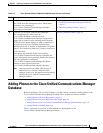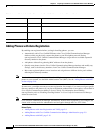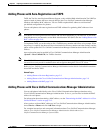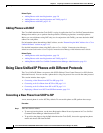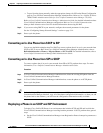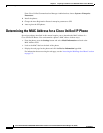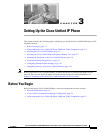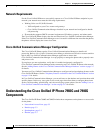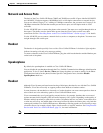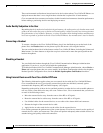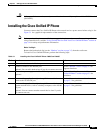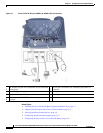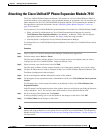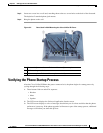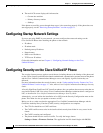
3-3
Cisco Unified IP Phone 7960G/7940G Administration Guide for Cisco Unified Communications Manager 7.0 (SCCP)
OL-15498-01
Chapter 3 Setting Up the Cisco Unified IP Phone
Understanding the Cisco Unified IP Phone 7960G and 7940G Components
Network and Access Ports
The back of the Cisco Unified IP Phones 7960G and 7940G have two RJ-45 ports labelled 10/100 SW
and 10/100 PC. Each port supports 10/100 Mbps half- or full-duplex connections to external devices.
You can use either Category 3 or 5 cabling for 10-Mbps connections, but you must use Category 5 for
100 Mbps connections. On both the network port and access port, use full-duplex mode to avoid
collisions.
Use the 10/100 SW port to connect the phone to the network. You must use a straight-through cable on
these ports. The phone can also obtain inline power from the Cisco Catalyst switch over these
connections. See the
“Providing Power to the Cisco Unified IP Phone” section on page 2-3 for details.
Use the 10/100 PC port to connect a network device, such as a computer, to the phone. You must use a
straight-through cable on this port.
Handset
The handset is designed especially for use with a Cisco Unified IP Phone. It includes a light strip that
indicates incoming calls and voice messages waiting.
To connect a handset to the Cisco Unified IP Phone, plug the cable into the handset and the Handset port
on the back of the phone.
Speakerphone
By default, the speakerphone is enabled on Cisco Unified IP Phones.
You can disable the speakerphone through the Cisco Unified Communications Manager Administration
application. To do so, choose Device > Phone and locate the phone you want to modify. In the Phone
Configuration window for the phone, Product Specific Configuration area, check the Disable
Speakerphone check box.
Headset
Although Cisco Systems performs internal testing of third-party headsets for use with the Cisco Unified
IP Phones, Cisco does not certify or support products from headset or handset vendors.
In some instances, the mechanics or electronics of various headsets can cause remote parties to hear an
echo of their own voice when they speak to Cisco
Unified IP Phone users.
Cisco recommends the use of good quality external devices, for example, headsets that are screened
against unwanted radio frequency (RF) and audio frequency (AF) signals. Depending on the quality of
headsets and their proximity to other devices such as cell phones and two-way radios, some audio noise
or echo may still occur. An audible hum or buzz may be heard by either the remote party or by both the
remote party and the Cisco Unified IP Phone user. Humming or buzzing sounds can be caused by a range
of outside sources; for example, electric lights, electric motors, or large PC monitors. See
Using External
Devices with Your Cisco Unified IP Phone, page 3-4, for more information.
Note In some cases, hum may be reduced or eliminated by using a local power cube or power injector.



